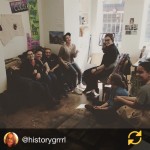Laura Schiavo’s article, Object Lessons: Making Meaning from Things in History Museums, got me thinking about the different ways in which the public interacts with history and in which historians interact with the public. Schiavo describes that today’s museums have a tendency toward larger themes and abstract concepts; the artifacts are often drowned out by the concepts they are intended to represent. While Schiavo (and I, as well) respects and appreciates that these types of exhibitions have gone a long way in reframing historical narratives, exposing hidden stories, and giving voices to silenced populations/figures, she argues that “the dominance of themes and stories, rather than collections, can mean a more limited engagement with artifacts.” (48) This is important because of the way in which I feel that many Americans interact with history.
Popular history, that which is seen in the mainstream media, is centered largely around an obsession with objects and artifacts. As I write, a copy of “History of the World in 1000 Objects” sits on my coffee table. American Pickers, a History Channel TV show focusing on two men who hunt for Americana relics to resell (though, to them, the story behind such items is far more valuable), has garnered a tremendous audience and many similar shows have sprung up in what was revealed as fertile ground. I’ve seen every manner of media, books to podcasts to Facebook groups, focusing on “do you remember what this was?” or “this item hearkens back to a time when…” There is something fundamentally grounding about items and objects. It takes an abstract memory or history and concretizes it, making it real to the viewer. An ancient Egyptian really was buried in this sarcophagus. A medieval nobleman actually used this signet ring to seal his documents. The abstract is difficult to wrap one’s mind around and even more difficult to make meaning from. Objects and artifacts bring abstract concepts of acculturation, class struggles, industrialization, and conquest (among countless others) down to earth and into focus.
That is not to say that objects should be the focus of exhibits and that conceptual presentations aren’t relevant to the public. Schiavo explains that “an idea-driven exhibition does not necessarily mean one where objects cannot have a bolder role to play.” (49) It is important to retain the conceptual drive of exhibitions, in order to continue reframing historical narratives and presenting more complex ideas and viewpoints to the public at large. However, historians need to meet the public in the middle and recognize the power of objects and artifacts to bolster and concretize the story that is being told. In fact, those objects could be integral to the retelling of that very story: “[American Stories] is the first history exhibition I have seen in a long time where it is the objects that motivate the text, instead of the other way around.” (50) There is no hard and fast divide between a conceptual exhibition and an artifact-driven exhibition. Either one without the other can fundamentally cripple the story being displayed. Artifacts pique the viewer’s interest in the concepts being argued. Those concepts widen the viewer’s perspective (ideally) and allow them to think more deeply and critically about the historical event. The artifact, then, concretizes that abstract thought and gives the viewer a relic off of which to build their understanding of that event.




